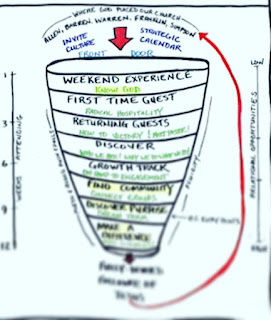Creating the Right Discipleship Path
Improving the weekend experience helps you expand the “front door” of your church. But on-ramps and next steps are what “closes the back door.” In ministry, the word “assimilation” is often used to describe the process of integrating a new person into the life of a church. I prefer the term Discipleship Path instead. Because every church should have a path where people can begin a journey to discover Jesus and deepen their faith. Unfortunately, many churches struggle with the creating the right next steps for people to start that journey. In many cases, this is what it looks like when someone attends church for the first time and then returns.
- First time guests are sent to a welcome center for a gift. The objective is to get their information for follow-up.
- The church sends an email or text to follow up, usually sharing more information about the church and its programs, or an upcoming event, like a Bible study.
- If they return, they are asked to attend some sort of membership class or meeting.
- If they take that step, they are usually encouraged to serve or join a small group.
Do you notice any issue with this process?
There’s a subtle but underlying assumption in the steps and their progression that the goal of connecting with this new person is to make them a church member.
But what if the guest is an unchurched person, unsure about faith but still willing to seek out the truth? What if this person was a single mom, going through a life crisis, who walked into your church looking for hope? What if this person was the unchurched, lost person every church should be reaching?
So what should a discipleship path look like? Imagine walking down a stream on a warm sunny day. In the beginning, the water is shallow. It's easy to walk and navigate. However, as you continue to walk you notice the water becomes a little deeper.
Eventually you come to a bend where another stream merges with the one you’re in. Now the current is a little swifter and there’s more depth. This is how a discipleship path should flow. It begins with people taking simple, shallow steps; steps they can navigate in their own time. Eventually, however, their steps must lead to relational opportunities where there is depth and current to help guide them to Jesus and begin a journey of faith.
If your discipleship path ends with a membership class, chances are you'll make members, but few disciples. And the unchurched person who needs hope probably won't make it to your class. You must create simple next steps that will lead to relational environments, where people can discover Jesus, your church and their own faith experience.
If your discipleship path ends with a membership class, chances are you'll make members, but few disciples. And the unchurched person who needs hope probably won't make it to your class. You must create simple next steps that will lead to relational environments, where people can discover Jesus, your church and their own faith experience.
If membership classes and Bible studies made disciples, churches would be full. There is no shortage of either in most churches. This is why the discipleship path is critical to the mission of the church. The church should always be a place where anyone can take a next step on a journey faith and following Jesus.
TAKE YOUR NEXT STEP
Evaluate your current discipleship path as a leadership team. A few questions to get you started:
- What is “the win” for your path? Does your path make sense for an unchurched person?
- Are the first time guest steps simple and do they match what a first time guest actually needs?
- How are you measuring each step?
- Are you using clear language that would make sense to someone with no church background?
- How many new guests are actually communicating with you or going to a designated place? How might you improve that number?
Get more helpful resources on this and other topics at The Unstuck Group.




Comments
Post a Comment